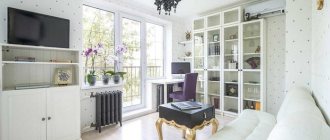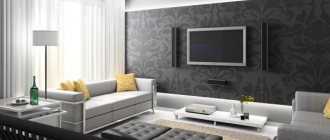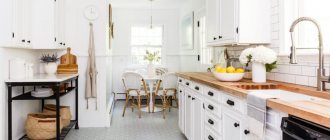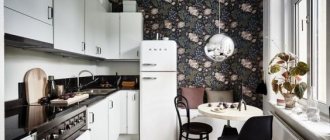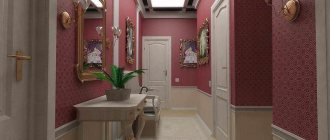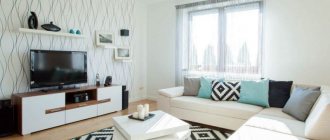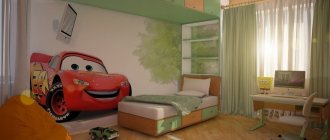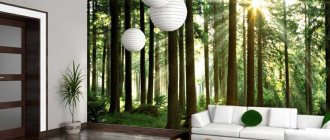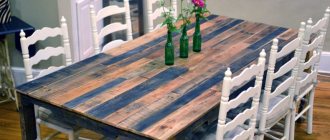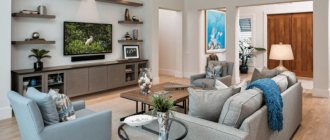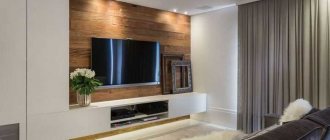| The best time to buy New Year's gifts is right now! Find the best gift ideas for Men, Women, Girls and Boys. |
The perception of the interior of the hall - the key room in the home - is largely determined by the type of wall decoration, so during the renovation process you should not neglect the rules for choosing and combining wallpaper.
Many options for their combinations allow you to give the space an original look, make it cozy, comfortable and atmospheric, while spending a minimum amount of financial resources.
Basic rules for combining
Designers usually insist on a combination of wallpapers. This allows you to give the room an original look, choose the right different textures, shades and patterns.
This finishing method has advantages:
- smoothing out the disadvantages and emphasizing the advantages of the hall;
- camouflage of a specific layout;
- delineation of areas for entertainment and recreation.
When choosing canvases, take into account the height of the ceiling, the location of windows and doors, the presence of niches and the degree of lighting.
When creating a combined design yourself, you should follow a number of rules. Before purchasing, you should decide on such nuances as:
- Type of interior (classic, high-tech, avant-garde, art deco, empire, antique).
- Basic wall color. Subsequent decor and accentuation elements are based on it.
- Type of texture: smooth, embossed or textured.
- Drawing and its size. It can be subject, floral, geometric, abstract.
- The compatibility of canvases and available accessories - curtains, furniture, decor.
In order for the combination of wallpaper to be successful, it is worth thinking through the entire interior in detail in advance. It is better to choose wall coverings after purchasing furniture and decorative items. Because the main purpose of this design is to emphasize the living room decor.
Combining different types of textures and shades will help create a unique style. The organic nature of the room depends on the correctly selected color scheme. Wallpaper combinations allow you to divide even a small room into an area for dining, playing and relaxing.
After viewing photographs of finished interiors, you can choose the appropriate option. It is also worth considering the area of the room and the height of the ceiling. Light wall colors are a good solution for a small, ill-planned room, as they visually expand the space.
Bright shades visually narrow the room, so they look good only in a living room with a large square area. But accent wallpaper in dark colors allows you to compensate for the elongated or irregular shape of the room. By gluing such a canvas on a narrow area, you can “bring it closer”, optimizing the space.
You should not place the main emphasis on the wallpaper. This design looks boring. And the combination of bright textured walls and original furniture seems unnecessary. The canvas should ideally be in harmony with the decor, creating comfort and not attracting maximum attention.
The classic option is pastel-colored wallpaper. For such a room you will need interesting furniture so that the interior does not become ordinary. If you combine two or three types of pastel-colored wallpaper in a room and place bright accents, you will be able to create an interesting and unobtrusive design.
Paired canvases should be connected according to texture or appearance. Walls with a similar pattern or the same background look harmonious in the room. Contrasting shades emphasize activity and uniqueness. The combination of photocells with a single-color coating is also relevant.
Wallpaper design for the living room in different styles
You can choose wallpaper for renovation based on common styles, for example:
- The classics are a textbook in design. To do this, use designs of plant ornaments, monograms, stylized patterns and soft shades.
- Imitation of natural surfaces made of stone, leather, fur and wood - modern. Prints in natural shades and mosaics look elegant and expressive.
- Smooth surfaces with a glossy sheen, metallic shades, black, white, gray plain canvases correspond to the high-tech style.
- Warm and light background, discreet and simple, with simple bouquet arrangements - Provence.
- Elements with an unplastered surface, the effect of old walls, and decorative inserts belong to the loft style.
Wallpaper in the Japanese style, in the traditions of minimalism and country music, is widely used.
Selection of wallpaper by color and pattern
When choosing the shade of the walls, they start from the existing furniture and other decor (curtains, bedspreads, paintings). The color of the rolls should match the decor or be a little lighter.
Expert opinion
Olga Kovalenko
Since 2010 I have been engaged in interior design and architectural design.
Too bright colors or variegated patterns predispose to depression.
When purchasing wallpaper yourself, you should remember the batch number. It is better to buy rolls from one manufacturer. This fabric will have an equal thickness, so the joints and seams will be invisible.
How to combine colors correctly:
- Red or purple looks good with silver, emerald, blue, coffee and light brown. But you shouldn’t combine it with golden, yellow, orange and purple. It looks tacky.
- Pink goes with dark red and silver gray. You can add a little brown. Celadon, electric blue and bright red are prohibited.
- Orange can be combined with white, beige and light green. These combinations are suitable for a room with lilac or violet decor.
- Brown is combined with gold or bright blue.
- Yellow harmonizes with wooden furniture and green shades of the interior.
You can combine not only wallpapers of two colors, but also with different patterns. For example, a small room looks more spacious when combining a plain fabric with or without a pattern. Rolls with stripes, patterns or monograms allow you to highlight one of the walls.
If the hall is rectangular, you can visually expand the area with a horizontal combination of ornaments. Vertical combination allows you to “stretch out” a living room with a low ceiling.
Pastel shades with abstract or geometric patterns look great in small rooms. A large pattern reduces space.
A covering reminiscent of wood or bamboo can be combined with a floral print, narrow stripes with abstraction or a cage.
Possible options
There are many types of wallpaper that can be used to beautifully decorate the walls of the living room of a house or apartment. The materials differ in the form of release and come in rolls and packages. Of the first, it is worth giving preference to varieties with a width of 1 m or more (up to 1.3 m). The latter are sold in the form of a dry powder or a ready-made wet mixture, for which they are called “wet”. This wallpaper provides seamless application technology.
Worthy of attention are:
- paper - budget varieties of one- and two-layer type, often having a smoothed surface appearance;
- vinyl - expensive varieties on a vinyl and non-woven base, one of the most durable, high-quality, beautiful, practical and easy to paste;
- non-woven wallpaper is one of the best wallpapers today, environmentally friendly, can decorate the surface of walls for up to 15 years;
- textile - premium woven wallpaper, made from textile fibers glued to a paper backing, is distinguished by its capriciousness in pasting and durability;
- photo printing – photo wallpaper with different images, presented in the form of a single sheet or component parts (with a large picture);
- glass wallpaper - durable wall material (operation for 20-30 years) made of glass fibers, which are woven and treated with special impregnations to fix a clear shape;
- liquid - bagged wallpaper, which is applied with a roller, spray gun, spatula, evenly distributed over the surface of the walls.
Each category has its own pros and cons. Some of the described varieties involve repeated painting of the surface with a paint roller, which allows you to update the interior of the room as desired.
For tips on choosing wallpaper, see the following video.
Popular combination methods
You can combine wallpaper to create an interesting room design in an apartment in different ways. They select canvases based on similar or contrasting shades, and combine different pasting methods to visually expand the room or improve its shape.
By related colors
The design of wallpaper for the living room depends on the ability to combine rolls in a general scheme. To do this, use 2 methods:
- A combination of two tones of the same color. For example, the classic combination of golden and brown. This wall design looks elegant and stylish.
- Combining different shades of pastel colors. Translucent, dim colors harmonize well, visually enlarge the room, giving the interior lightness.
If you need to highlight separate zones in the hall, then wallpaper 2 shades darker would be suitable for relaxation, and lighter than the base ones for eating.
By contrasting colors
Shades that are not next to each other on the color wheel, but on the opposite side, are called complementary or contrasting. These are combinations of blue and orange, green and red, purple and light yellow.
Combining such aggressive tones is acceptable when decorating a living room for young people. But it is important not to overdo it, since an unsuccessful combination depresses the psyche and causes pain in the eyes.
Bright and pastel shades look good on plasterboard or frame partitions in studio apartments, in the living room combined with the kitchen.
You need to experiment carefully, or better yet, entrust the interior to a designer. Otherwise, you can get the wrong result for a lot of money.
Combination by gluing method
There are many options for combining wallpaper using pasting methods. They can be placed on the living room walls horizontally, vertically or diagonally. It is important that the result is harmonious and that the owner likes it.
The classic design of the hall involves the following variations:
- Vertical and horizontal pasting: rolls of different textures or shades are alternated either parallel to the floor or perpendicular. The transverse layout is used for Provence style interiors, and the longitudinal layout is used to highlight individual zones.
- Inserts of contrasting colors. If the living room is decorated in a classic style, they are decorated with frames. In modern times, they are combined into an avant-garde panel or painting.
- Wall highlights. The area on which the emphasis is placed is covered with a canvas of a complementary color. This design visually aligns the shape of the living room and masks the existing shortcomings of standard-plan apartments. This technique is recommended for a small or rectangular room.
Maps on the wall in the living room
Geographic maps will add sophistication to the design. At the same time, in classic interiors they are selected with light wear, in modern ones they are made clear and bright.
Design tips
Before purchasing wallpaper, you should decide on the interior. When choosing, take into account:
- room lighting;
- preferred color schemes;
- the desire to highlight or disguise niches or protrusions present in the room;
- existing furniture and interior items.
Expert opinion
Olga Kovalenko
Since 2010 I have been engaged in interior design and architectural design.
Usually, using the right combination of shades and textures, it is possible to create the desired design; dismantling is an extreme and expensive measure.
The color of wallpaper in building materials stores is different, and the roll you like may look slightly different in the room. This is taken into account when purchasing.
Having decided on the basic tone, they use it not only when decorating the walls, but also when selecting decorative elements - curtains, bedspreads, sofa cushions or paintings.
It is not advisable to combine fabrics with a washable and paper base, since they differ in care. Getting paper rolls wet causes them to thin and peel. As a result, partial replacement of the coating will be required. Therefore, designers and builders advise choosing wallpaper that is the same in structure.
It is necessary to take into account the effect of ultraviolet radiation when exposed to sunlight. Monograms and bright ornaments may fade or turn yellow.
A good solution for families with small children who love to draw on the walls is to decorate the play area in the hall with chalk cloth. It can be used instead of a board, and the “art” can be removed by wiping it with a damp sponge.
“Khrushchevkas”, which solved the housing problem for residents of the capital and other Russian cities, are not particularly spacious, but are still in use today. Demolition of such houses began 2 years ago in Moscow. In their living room, a classic, retro or Provence style looks organically.
Beautiful ideas
To choose a suitable example of your future environment, you can take a closer look at examples of beautiful design. This will allow you to understand how best to arrange the room. An accent wall with horizontal chalkboard stripes harmonizes with the ledge in a single color scheme.
Wallpaper with relief and photo printing highlight the brutal sofa and fit into the loft style.
A canvas depicting continents is appropriate near the fireplace area in a single color scheme.
Photo wallpaper perfectly hides the broken plane of the wall, giving it originality.
Continental stylization against the background of plain canvases looks stylish and fashionable.
Wallpaper with silk-screen printing looks noble, highlighting an area with a plasma and a narrow cabinet for equipment.
In a creative design, photo wallpaper with a large fragment pattern, made to match the furniture, is appropriate.
Realistic photo printing on the entire wall with a city view will visually make the space larger.
Wallpaper as a background for furniture
The hall is not always a separate room; it is often included in the multifunctional kitchen-living room or studio as part of it. Such apartments require universal solutions and zoning.
Bed and snow-white tones, gray, green-bluish, lilac, vanilla, pink light wallpaper will fit into the interior with light furniture.
Neutral tones look good with baroque, neoclassical or classic furnishings.
How to combine the color of wallpaper with the color of furniture in the living room
Background wallpaper should highlight or highlight the furniture, but not take all the attention to itself. In this sense, it is easier to purchase new wallpaper than to change the decor of the room
For dark items, warm sand, mustard or pear shades are suitable.
White furniture provides a wide choice for the designer. It doesn’t have to be shaded with a dark coating. The main thing is that it does not blend into the background. Suitable colors:
- sapphire;
- emerald;
- purple.
To give the room an atmosphere of calm, you will need beige, cream or light blue shades. If there is cherry furniture, then the background can be green, purple or burgundy.
Today, blue furnishings are considered fashionable; they will look spectacular against the background of yellow and red tones.
Creating a panel
The use of an improvised decorative panel, for the creation of which expensive, luxurious designer wallpaper was taken, also allows you to create interesting decorative accents in the room. A living room with such an accent usually has a significant area, since the decor itself is usually made quite large.
Photo wallpapers with a 3D effect in a modern design bear little resemblance to landscapes with exotic palm trees and waterfalls. The technical capabilities of printing allow you to create pixel paintings in the style of computer games or adapt masterpieces of world painting to interior design. The imitation of forging, stucco, wood carving or stained glass looks interesting.
If a panel is used to decorate a TV area or a niche in which a false fireplace or columns are installed, deep, complex colors and matte textures are used here. When combined in this way, wallpapers with imitation of natural stone, bare concrete, and brick look interesting.
Photo wallpaper
The most effective and beautiful way to make a small room visually larger is to use photo wallpaper for decoration. True, not all drawings can give the desired result, so it is worth taking into account the characteristics of each canvas.
To increase the space, you should choose wallpaper on which the images will tend to go deeper into the picture. This could be a photo of a street in a big city, a forest path or an underwater world.
A panorama of the city of different sizes or an image of nature will help create a special atmosphere in the room. Volumetric landscapes or individual elements of trees, bushes, bamboo or reeds create the effect of presence. Psychological immersion in the visual effects of photo wallpaper is an excellent antidepressant.
If you choose photo wallpaper correctly, you can visually expand a small room or make it more square if the room has the shape of an elongated rectangle.
For many, gluing photo wallpaper is a difficult process, but there are secrets that will allow you to quickly stick a panel in a small room:
- Photo wallpaper must be glued on a wall without door or window openings;
- a wall with such decoration cannot be cluttered with furniture and paintings cannot be hung on it; a sofa or table is appropriate here;
- if the room is very small, then you should choose photo wallpaper with a light pattern.
You can add space and dimension to the room using built-in lighting to the wallpaper. To realize this effect, the backlight colors must be matched to the tones present on the wallpaper. Using just white light is ineffective; it can give the opposite effect, illuminating the boundaries of wallpaper, walls and other objects, thereby eliminating the effect of volume.
Noise insulation
In apartments, the issue of sound insulation is sometimes very acute. You can try to hide from noise coming from outside, or try to protect your neighbors from your noise if there are small children living in the apartment, barking dogs, or the owners like to listen to music at full volume.
Of course, nothing will drown out the sound of a hammer drill, but you can ensure that you do not hear the cry of a neighbor’s child or a quarrel between neighbors.
Some types of wallpaper, for example, vinyl and non-woven wallpaper, provide some noise insulation. Thanks to their high density and artificial turf, they create a small sound barrier.
It is clear that serious noise problems cannot be solved with wallpaper alone. There is special sound insulation for the wallpaper in the apartment.
- paper backing is an environmentally friendly material, but it rather levels the surface and makes its tone uniform than soundproofing;
- non-woven backing levels the walls, allows steam and moisture to pass through, maintaining optimal humidity in the room, and has average sound insulation;
- The polyethylene foam backing has high sound insulation characteristics and also works as insulation. The downside is that the material does not “breathe”, so moisture will not be removed from the room.
- cork backing is an ideal option for both sound and thermal insulation. Breathable, environmentally friendly material, suitable even for children's rooms. Different thicknesses allow you to select the desired level of sound insulation for real conditions.
